Did you know that Romania is home to over 7,000 protected natural areas? These conservation areas are dedicated to preserving Romania’s rich biodiversity and sacred natural sites. From ancient mythological places to breathtaking landscapes, Romania’s commitment to wildlife conservation and the preservation of its spiritual heritage is truly awe-inspiring.
Key Takeaways
- Romania boasts over 7,000 protected natural areas, demonstrating its commitment to biodiversity preservation.
- These conservation areas play a crucial role in safeguarding Romania’s sacred natural sites and unique landscapes.
- Romania’s rich biodiversity is showcased through its diverse ecosystems, supporting a wide range of flora and fauna.
- The integration of cultural and spiritual values into conservation practices is a key aspect of Romania’s approach to wildlife preservation.
- By prioritizing sustainable development and engaging local communities, Romania exemplifies the harmonious interaction between humans and nature.
Romania’s Cultural and Ethnic Diversity in the Carpathian Region
The Carpathian region in Romania is renowned for its cultural diversity and rich ethnic groups. While the Romanians form the majority, this multicultural region is home to various minority communities from neighboring countries. These include Russians, Jews, Germans, Greeks, Armenians, and Roma, each contributing to the region’s vibrant tapestry of cultures.
Within the Carpathian region, several distinctive ethnic groups have their roots. The Rusyns, Lemkos, Bojkos, Hutsuls, Górals, Szeklers, Csángos, and Mot¸i all possess unique beliefs, dialects, and ethnic traditions. Their presence adds depth to the region’s cultural fabric, making it a focal point for those interested in exploring Romania’s multicultural heritage.
This fascinating coexistence of diverse ethnic backgrounds makes the Carpathian region an extraordinary cultural destination. Visitors can immerse themselves in the traditional customs, culinary delights, festivals, and artistic expressions of these ethnic communities, creating a rich tapestry of cultural encounters.
The Carpathian region in Romania is a remarkable example of how cultural diversity enriches a region, fostering understanding, tolerance, and appreciation for different traditions and ways of life.
Ethnic Groups in the Carpathian Region
| Ethnic Group |
Origin |
Main Locations |
| Rusyns |
Carpathians, Ukraine, Poland, Slovakia |
Maramureș County, Bukovina |
| Lemkos |
Eastern Carpathians, Poland, Slovakia |
Maramureș County, Harghita County |
| Bojkos |
Carpathians, Poland, Slovakia |
Maramureș County |
| Hutsuls |
Carpathians, Ukraine |
Maramureș County, Bucovina, Transylvania |
| Szeklers |
Transylvania, Eastern Carpathians, Hungary |
Covasna County, Harghita County |
With its cultural diversity and ethnic vibrancy, the Carpathian region is a testament to Romania’s commitment to fostering a multicultural society and celebrating the richness that different cultural traditions bring. Whether exploring the historical landmarks of these ethnic groups or experiencing the warmth and hospitality of local communities, visitors to the Carpathian region will undoubtedly submerge themselves in a realm of cultural wonders.
Ancient Sacred Sites in the Carpathian Mountains
The Carpathian Mountains region is home to fascinating ancient sacred sites that are rooted in the rich history of the Geto-Dacian civilization. Dating back to around 1000 BC, this civilization flourished throughout the Carpathians and worshipped their main deity, Zamolxe.
Ancient sacred places nestled in the Carpathian Mountains often hold deep spiritual significance and are associated with intriguing folklore and mythological stories surrounding Zamolxe. These places, frequently found in caves or tunnels, have captivated the imagination of locals and visitors alike.
“The legends and mysteries of the Geto-Dacians’ ancient sacred sites in the Carpathian Mountains continue to intrigue and inspire. These sites offer a glimpse into the spiritual practices and beliefs of a civilization that once thrived in this region.”
Two prominent locations that are steeped in the myths and legends of the Geto-Dacians are Bucegi Mountain and Ceahla˘u Mountain. These majestic peaks not only carry historical significance but also provide breathtaking natural landscapes that beckon adventurers from around the world.
Exploring the ancient sacred sites in the Carpathian Mountains allows visitors to delve into the mysteries of the Geto-Dacian civilization, immerse themselves in Carpathian folklore, and experience the enchanting beauty of Bucegi Mountain and Ceahla˘u Mountain.
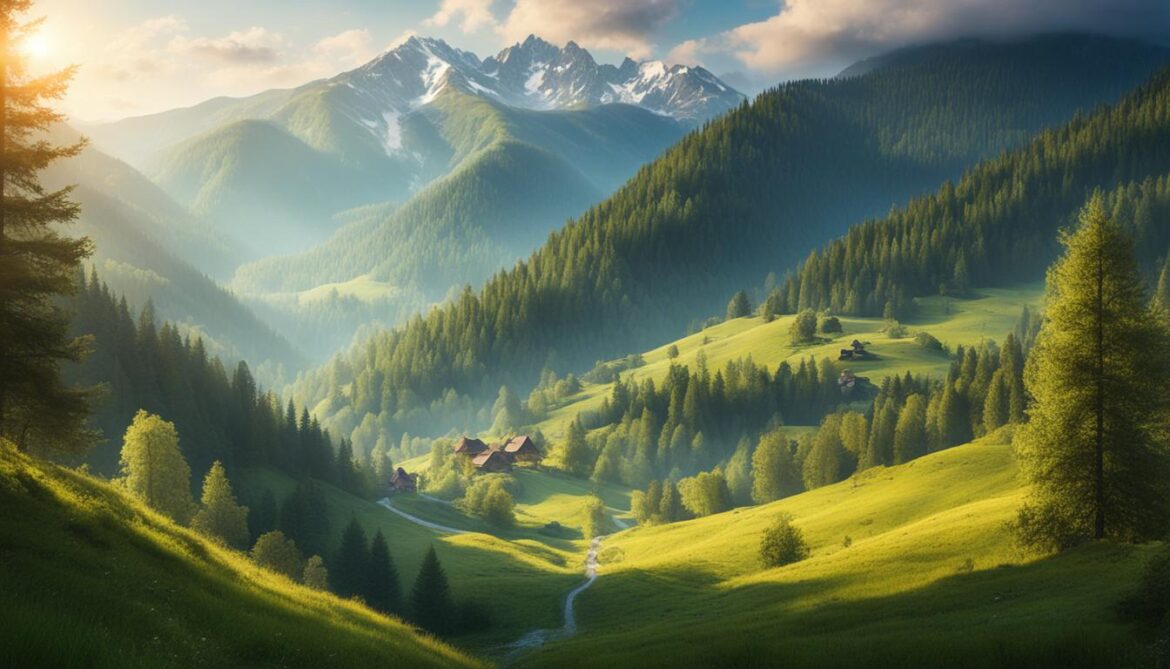
| Ancient Sacred Sites |
Location |
| Bucegi Mountain |
Carpathian Mountains, Romania |
| Ceahla˘u Mountain |
Carpathian Mountains, Romania |
Discover the Mysteries of Bucegi Mountain
Nestled in the Carpathian Mountains of Romania, Bucegi Mountain is a haven of ancient sacredness and natural splendor. This majestic peak is often associated with the Geto-Dacian civilization and is steeped in mythological stories.
Explorers of Bucegi Mountain will be awestruck by its awe-inspiring landscapes, rugged cliffs, and hidden caves that hold secrets of the past. It is a place of mystery and wonder that continues to intrigue researchers and adventurers alike.
Immerse Yourself in the Legends of Ceahla˘u Mountain
Ceahla˘u Mountain, located in the Carpathian Mountains of Romania, is another ancient sacred site shrouded in myth and folklore. Known as the “Holy Mountain,” Ceahla˘u holds a special place in the hearts of locals and is a beacon for those seeking a spiritual connection with nature.
Visitors to Ceahla˘u Mountain can hike through its picturesque trails, encounter the diverse flora and fauna, and immerse themselves in the legends and stories that have been passed down through generations. It is a place where spirituality and natural beauty intertwine.
Romania’s Natural Parks and Protected Areas
Romania is renowned for its natural parks and protected areas, which serve as vital spaces for conserving and safeguarding the country’s unique landscapes, diverse flora, and abundant fauna. These protected areas are dedicated to preserving the natural heritage of Romania and promoting sustainable tourism.
One of the key types of protected areas in Romania is the Natural Parks, which focus on safeguarding specific natural features, geological formations, and representative ecosystems. These parks play a crucial role in preserving the distinct characteristics of their respective regions. For instance, the majestic Bucegi Natural Park, nestled in the Carpathian Mountains, showcases breathtaking landscapes and rich biodiversity. The park’s snow-capped peaks, deep valleys, and dense forests provide a habitat for numerous plant and animal species, making it a hotbed for nature enthusiasts and conservationists alike.
Romania also boasts several National Parks that encompass larger areas and have a broader scope of conservation. These parks serve as extensive habitats for a wide array of flora and fauna, providing a sanctuary for endangered species and promoting biological diversity. The Munții Maramureșului Natural Park, located in the northern part of Romania, is a prime example of a National Park that protects both remarkable landscapes and unique wildlife. This rugged area is characterized by its dense forests, pristine rivers, and stunning waterfalls, making it a haven for various plant species, large carnivores, and migratory birds.
These natural parks and protected areas not only serve as conservation sites but also provide educational opportunities for visitors. They offer a chance to learn about Romania’s natural heritage, the importance of preserving biodiversity, and the various species that call these areas home. Guided tours, educational programs, and interpretive centers within these parks ensure that visitors gain a deeper understanding of the significance of sustainable tourism and the role they can play in protecting and conserving Romania’s natural treasures.
The table below highlights some of Romania’s notable natural parks and protected areas:
| Natural Park/Protected Area |
Location |
Main Features |
| Bucegi Natural Park |
Carpathian Mountains |
Breathtaking landscapes, diverse flora and fauna, including brown bears and chamois. |
| Munții Maramureșului Natural Park |
Northern Romania |
Rugged terrain, dense forests, pristine rivers, and waterfalls, supporting diverse wildlife. |
| Retezat National Park |
Western Carpathians |
Glacial lakes, jagged peaks, old-growth forests, and a rich variety of plant and animal species. |
| Delta Dunării Biosphere Reserve |
Danube Delta |
A vast wetland ecosystem, recognized as a UNESCO World Heritage Site, with a remarkable variety of bird species. |
| Cheile Nerei-Beușnița National Park |
Western Romania |
Spectacular canyons, waterfalls, and caves, home to rare and endemic plant species. |
These natural parks and protected areas are a testament to Romania’s commitment to biodiversity preservation and sustainable tourism. They offer visitors an opportunity to witness the beauty of Romania’s unique landscapes, immerse themselves in its rich and diverse flora and fauna, and contribute to the conservation efforts that aim to ensure the long-term sustainability of these natural treasures.
Romania’s Sacred Natural Sites and Wildlife Conservation
Romania’s sacred natural sites are invaluable for both wildlife conservation and sustainable development. These sites provide a unique habitat for endangered species and play a crucial role in maintaining a balanced ecosystem.
The monastic communities in Romania have embraced the responsibility of conservation, ensuring a harmonious coexistence between humans and nature. These communities follow a sustainable economic model that emphasizes self-sufficiency and traditional farming practices.
“Our commitment to conservation is deeply rooted in our spiritual values. We see ourselves as guardians of the natural world, protecting endangered species, habitats, and cultural landscapes,” says Father Adrian, a monk from the Sihăstria Monastery.
The sustainable management practices of these monastic communities serve as inspiring examples for effective wildlife conservation. By integrating spiritual values with conservation efforts, these communities have created a model that encourages a holistic approach to nature preservation.
From the reforestation initiatives led by monastic communities to the protection of endangered species, the impact of their work extends far beyond the boundaries of the monasteries. Through their efforts, they promote a deeper understanding of the importance of biodiversity and its conservation.
Conservation through Spiritual Values
The spiritual values upheld by monastic communities provide a unique perspective on environmental stewardship. These values emphasize the interconnectedness between humans and nature, fostering a deeper sense of responsibility towards the natural world.
The monastic communities actively engage in habitat restoration, ensuring the preservation of biodiversity in their surrounding areas. Through their sustainable land use practices, they promote agro-biodiversity, supporting the growth of diverse plant and animal species.
Their commitment to balanced management extends beyond the boundaries of their own lands. Monastic communities actively collaborate with environmental organizations and local communities to promote sustainable development and conservation efforts in broader regions.
The Role of Monastic Communities
Monastic communities in Romania have become key stakeholders in wildlife conservation. By focusing on sustainable practices and self-sufficiency, they contribute to the preservation of natural resources, while also preserving the cultural and spiritual heritage of the country.
Their presence in sacred natural sites helps raise awareness about the importance of protecting these areas and the endangered species that inhabit them. The monastic communities serve as custodians, ensuring the long-term survival of these sacred sites for future generations.
| Monastic Community |
Role in Conservation |
| Sihăstria Monastery |
Protection of endemic plant species |
| Putna Monastery |
Conservation of large carnivores |
| Cozia Monastery |
Promotion of sustainable agriculture |
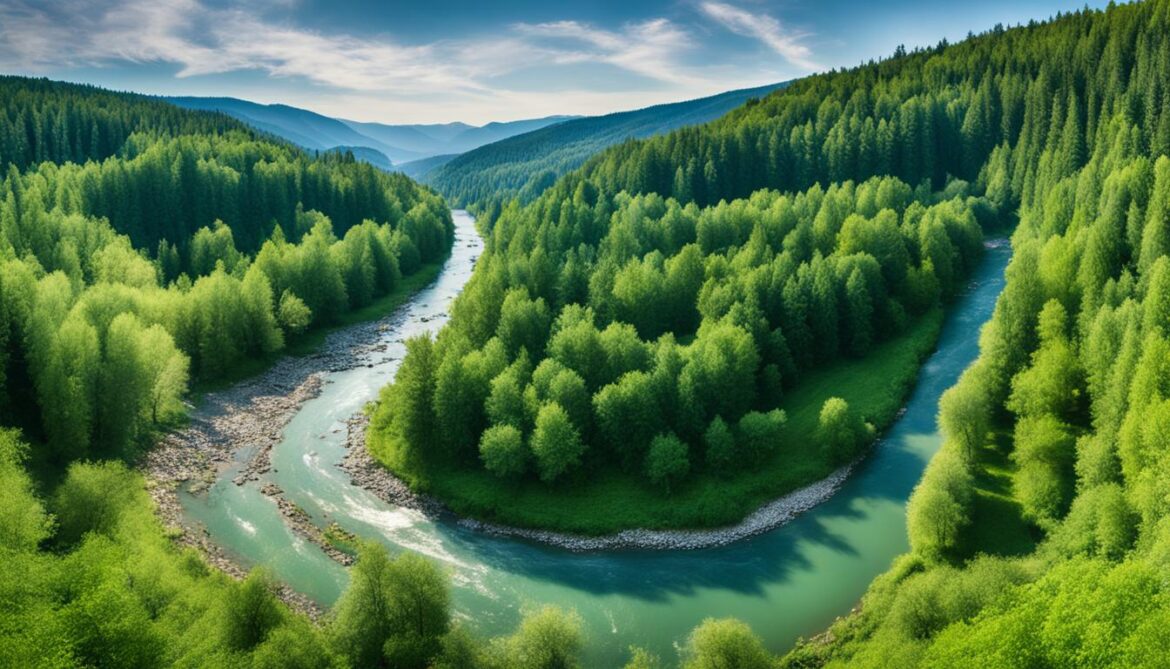
Romania’s Unique Biodiversity and Natural Resources
Romania is blessed with a remarkable abundance of biodiversity, showcasing approximately 2,650 recorded species within its borders. This diverse range of flora and fauna includes endemic, rare, and endangered species, making Romania a haven for unique and precious wildlife.
The country’s ecosystems offer a variety of habitats that support this rich biodiversity. The lush forests, expansive grasslands, and sprawling wetlands provide essential homes for a wide range of plant and animal species. These diverse habitats contribute to the overall health and resilience of Romania’s natural environment.
One of the notable highlights of Romania’s biodiversity is its population of large carnivores. The country is home to magnificent brown bears and majestic wolves, roaming freely in their natural habitats. These apex predators play a vital role in maintaining the ecological balance and are a significant indicator of a healthy ecosystem.
The iconic European bison, a symbol of strength and resilience, holds a special place in Romania’s natural heritage. Through dedicated conservation efforts, this magnificent creature has been successfully reintroduced into the wild, ensuring its survival for future generations.
The Romanian government recognizes the importance of preserving these natural resources. Conservation initiatives and protected areas are established to safeguard the unique biodiversity found in the country. By prioritizing the conservation of forests, maintaining habitats, and implementing sustainable land management practices, Romania is committed to securing the future of its diverse wildlife.
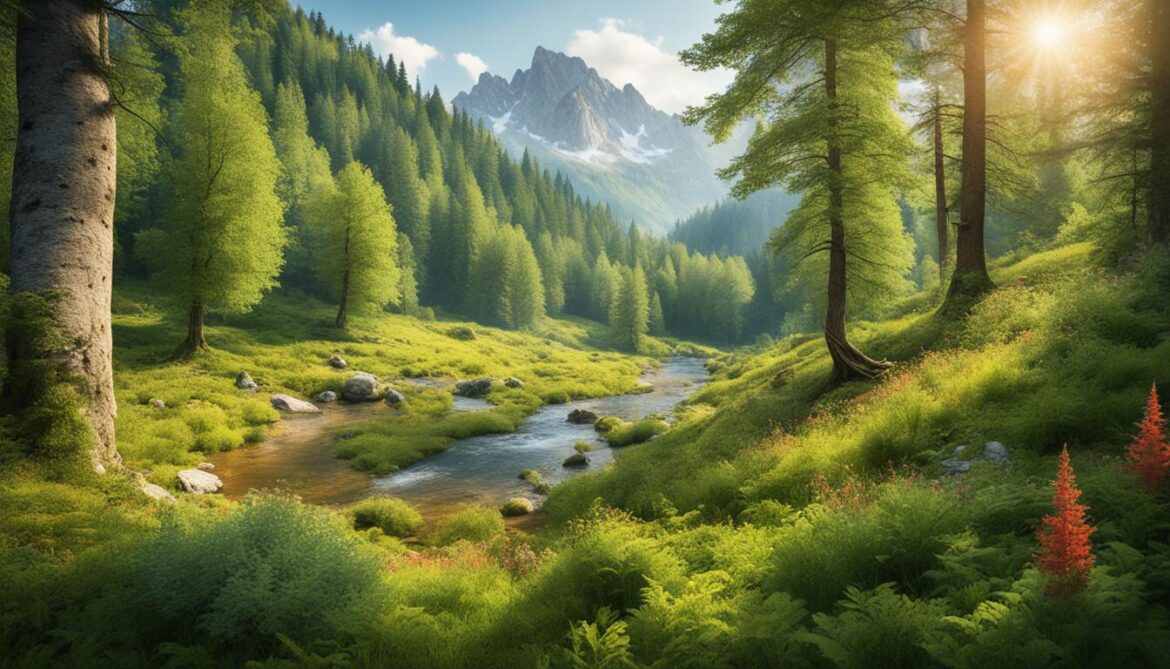
The Importance of Forest Habitats
Forests are of paramount importance in supporting Romania’s biodiversity. They provide crucial shelter, nesting grounds, and foraging areas for countless species. Romania’s forests are not only home to large carnivores like bears and wolves but also sustain diverse bird populations, smaller mammals, reptiles, and an array of insect species.
These forest habitats act as important ecological corridors, allowing for the movement of wildlife across the landscape. This connectivity is vital for maintaining healthy populations and genetic diversity, ensuring the long-term survival of species.
“The forest has its own language, and those who listen carefully can hear the whispers of nature’s incredible diversity.” – Romanian proverb
Preserving Romania’s Biodiversity for Future Generations
The conservation of Romania’s unique biodiversity is not only essential for the well-being of its wildlife but also for the cultural and economic value it brings. The country’s natural heritage attracts nature enthusiasts, adventurers, and eco-tourists from around the world, contributing to local economies and raising awareness about the importance of biodiversity conservation.
By protecting and responsibly managing its natural resources, Romania ensures the perpetual beauty and ecological integrity of its landscapes for generations to come. The government’s commitment to sustainable practices and the preservation of endemic species, forest habitats, and large carnivores serves as an inspiring example for countries worldwide, demonstrating the harmonious coexistence of humans and nature.
Governance and Management of Romania’s Natural Parks
The governance and management of Romania’s natural parks involve collaboration between various stakeholders, including the National Forest Administration and local authorities. These parks are governed by a comprehensive management framework aimed at integrating the conservation of natural, cultural, and spiritual heritage.
Romania Nature Park governance is primarily overseen by the National Forest Administration, which implements policies and regulations to ensure the sustainable preservation of these valuable natural areas. Through effective coordination and cooperation, the National Forest Administration works closely with stakeholders to develop and implement conservation strategies.
Stakeholder engagement is a crucial aspect of Romania’s natural park management, as it fosters inclusivity and harnesses the collective expertise and resources of various individuals and organizations. Engaging stakeholders, such as local communities, NGOs, and scientific institutions, allows for more effective decision-making and the development of conservation strategies that are both environmentally sustainable and culturally sensitive.
The integrated management approach adopted in Romania’s natural parks ensures that the conservation of biodiversity is balanced with the preservation of cultural and spiritual values. Through the integration of different disciplines and perspectives, such as ecology, anthropology, and spirituality, Romania strives to create comprehensive management plans that are holistic and well-rounded.
“The conservation strategies implemented in Romania’s natural parks take into account not only the ecological aspects but also the spiritual values associated with these natural areas,” says Dr. Ioana Popescu, a leading expert in biodiversity conservation.
Conservation strategies in Romania’s natural parks go beyond traditional nature preservation methods and embrace the spiritual values embedded in these areas. This approach acknowledges that cultural and spiritual connections with nature influence people’s attitudes and behavior towards the environment. By incorporating these values into conservation efforts, Romania can better engage local communities and promote a sense of stewardship towards their natural heritage.

| Benefits of Romania’s Natural Park Governance |
Key Features |
| Preservation of Natural Heritage |
Integration of natural, cultural, and spiritual values in conservation strategies. |
| Sustainable Management |
Collaboration between the National Forest Administration, local authorities, and stakeholders. |
| Community Engagement |
Inclusion of local communities, NGOs, and scientific institutions in decision-making processes. |
| Integrated Approach |
Blending ecological, anthropological, and spiritual perspectives for comprehensive management plans. |
| Cultural Sensitivity |
Recognition and incorporation of spiritual values associated with natural areas. |
Romania’s commitment to effective governance and management of its natural parks ensures the preservation of its diverse natural landscapes, cultural heritage, and spiritual values. By engaging stakeholders, integrating various disciplines, and embracing the interconnectedness of nature and spirituality, Romania sets a precedent for sustainable conservation practices.
Lessons Learned from Romania’s Natural Park Management
Romania’s experience in managing its natural parks provides valuable insights into the integration of cultural and spiritual values for effective nature conservation. By recognizing the significance of these values, Romania has not only enhanced awareness and education but also harnessed their potential for promoting ecotourism and sustainable development.
“The preservation of cultural and spiritual values can contribute to the long-term conservation of natural areas.”
One of the key lessons learned from Romania’s natural park management is the importance of acknowledging and respecting the cultural and spiritual heritage associated with natural sites. By valuing and incorporating these values into conservation practices, Romania has successfully fostered a deeper connection between visitors and the natural environment, generating a sense of responsibility and stewardship.
This approach has led to increased awareness among tourists, local communities, and policymakers, highlighting the integral role of cultural and spiritual values in preserving biodiversity and ecological balance. Moreover, it has provided a platform for education and dialogue, encouraging individuals to actively engage in conservation efforts and make sustainable choices in their daily lives.
Enhancing Ecotourism through Cultural and Spiritual Values
By leveraging cultural and spiritual values, Romania has transformed its natural parks into unique ecotourism destinations. The incorporation of sacred natural sites and their associated rituals and beliefs has created immersive, authentic experiences for visitors, enhancing their appreciation for the natural world while simultaneously supporting the local economy.
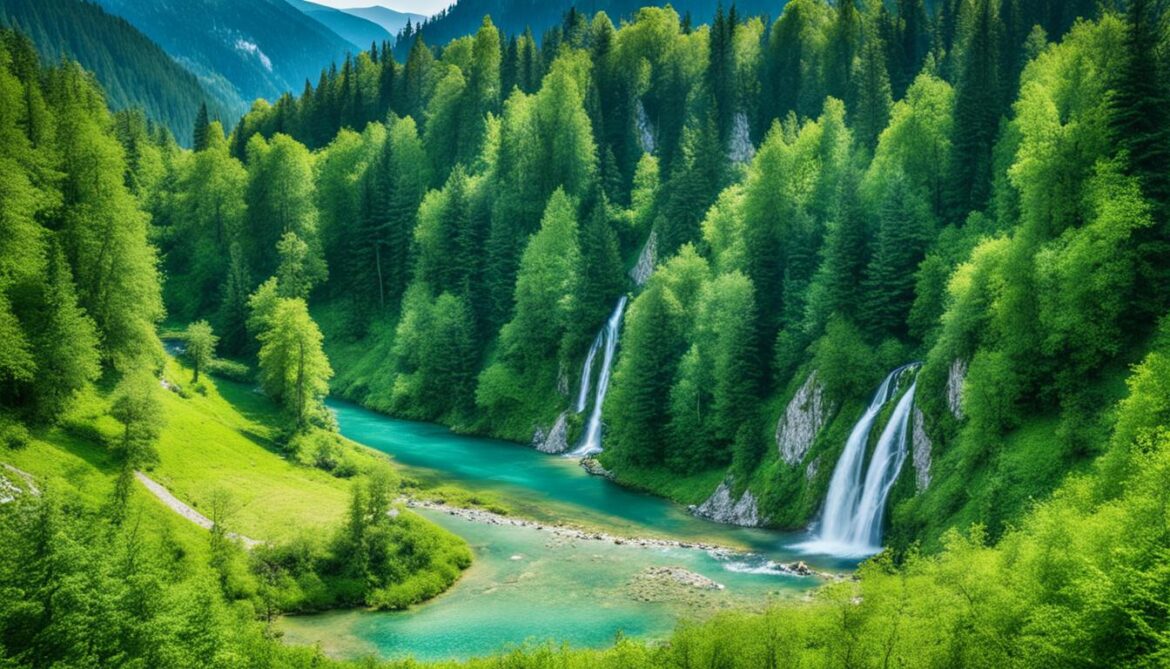
Local Engagement for Sustainable Development
Romania’s success in natural park management can be attributed to its emphasis on engaging local communities in conservation efforts. By involving and empowering local residents, Romania has fostered a sense of ownership and responsibility, ensuring the long-term sustainability of conservation initiatives.
- Creating educational programs and opportunities for local residents to learn about the cultural and spiritual significance of natural sites.
- Supporting sustainable livelihoods through ecotourism and traditional practices that align with nature conservation principles.
- Establishing collaborative platforms for dialogue and decision-making, enabling local communities to actively participate in shaping conservation strategies.
The Role of Cultural and Spiritual Values in Sustainable Development
By integrating cultural and spiritual values into nature conservation, Romania has exemplified how sustainability principles can be embraced and implemented on multiple levels.
The preservation of cultural and spiritual heritage contributes to the overall well-being of local communities, creating a sense of pride and identity while safeguarding traditional knowledge and practices. By nurturing these values, Romania has embraced a holistic approach to sustainable development, where economic growth is harmoniously balanced with ecological conservation and cultural preservation.
Awareness Raising for Nature Conservation
Romania’s natural park management has highlighted the importance of raising awareness about the cultural and spiritual values associated with natural sites. Through educational campaigns, interpretive signage, and community outreach, Romania has effectively communicated the significance of these values, fostering a sense of responsibility and inspiring individuals to become advocates for nature conservation.
| Lessons Learned from Romania’s Natural Park Management: |
| Cultural and Spiritual Values |
| Nature Conservation |
| Awareness Raising |
| Ecotourism |
| Sustainable Development |
These lessons learned from Romania’s natural park management demonstrate the immense potential of cultural and spiritual values in nature conservation. By embracing a holistic approach that incorporates these values into conservation practices, other regions can also enhance their efforts in preserving natural areas and promoting sustainable development.
Romania’s Monastic Traditions and Nature Conservation
Romania’s Christian monastic traditions play a vital role in nature conservation through sustainable land use practices. The monastic economic model, based on self-sufficiency and sustainable production, supports the conservation of local biodiversity and promotes agro-biodiversity.
Monastic communities have developed a harmonious interaction with the natural environment, recognizing the spiritual significance of nature and the interconnectedness between humans and the natural world. Their practices serve as inspiring examples of how traditional religious beliefs can be aligned with environmental conservation goals.
“The monks have a deep respect for the land and all living creatures. They view nature as a divine gift and strive to live in harmony with it. Through sustainable land use practices, they ensure the preservation of biodiversity while meeting their own needs.”
One key aspect of sustainable land use practiced by monastic communities is the cultivation of agro-biodiversity. They prioritize the preservation of heirloom and indigenous crop varieties, using traditional farming techniques that maintain soil fertility and minimize the use of synthetic inputs.
Self-sufficient Practices
Monastic communities in Romania embrace self-sufficiency as a core principle. They strive to meet their needs through their own sustainable practices, such as organic farming, beekeeping, and traditional crafts. By minimizing their reliance on external resources, they reduce their ecological footprint and prioritize local resilience.
The monastic way of life emphasizes simplicity and frugality, encouraging a mindful use of resources. Through their sustainable practices, these communities demonstrate the potential for self-sufficiency and inspire others to adopt similar practices.
Harmonious Interaction
Central to monastic traditions is the belief in the interconnectedness of all creation. Monastic communities view themselves as stewards of the natural world, called to protect and conserve it for the benefit of present and future generations.
The harmonious interaction between monastic communities and the environment is reflected in their land management practices. They prioritize conservation measures, such as reforestation and habitat preservation, to safeguard biodiversity and ecological balance.

Agro-biodiversity
Monastic communities in Romania actively promote agro-biodiversity, recognizing the importance of preserving traditional crop varieties and plant genetic resources. They play a significant role in safeguarding rare and endangered plant species, contributing to the preservation of Romania’s rich botanical heritage.
Through their cultivation of diverse crops, monastic communities contribute to ecosystem resilience and enhance the availability of nutritious foods. They prioritize traditional and organic farming methods, respecting the natural cycles of the land and minimizing the use of synthetic inputs.
The Cultural and Spiritual Significance of Romania’s Monastic Landscape
Romania’s monastic landscape holds great cultural and spiritual significance. It has been shaped and managed by Christian Orthodox monastic communities for centuries. The monastic traditions emphasize the sacredness of nature and the importance of living in harmony with the environment. Sacred sites within the monastic landscape are protected and integrated into management activities, ensuring their preservation. The sacred sites protection is an integral part of Romania’s commitment to the holistic approach to conservation, recognizing the interconnectedness of the spiritual values and the preservation of the country’s cultural heritage.
In this monastic landscape, spiritual values intertwine with the natural resources, creating a unique atmosphere where visitors can experience a deep sense of connection with both the cultural and natural aspects. The monastic communities serve as custodians of these sacred sites, promoting their significance and raising awareness about their importance in preserving cultural heritage. They offer guidance and support in understanding the spiritual values associated with the land, enriching the visitor experience and fostering a greater appreciation for the interplay between spirituality, culture, and the environment.
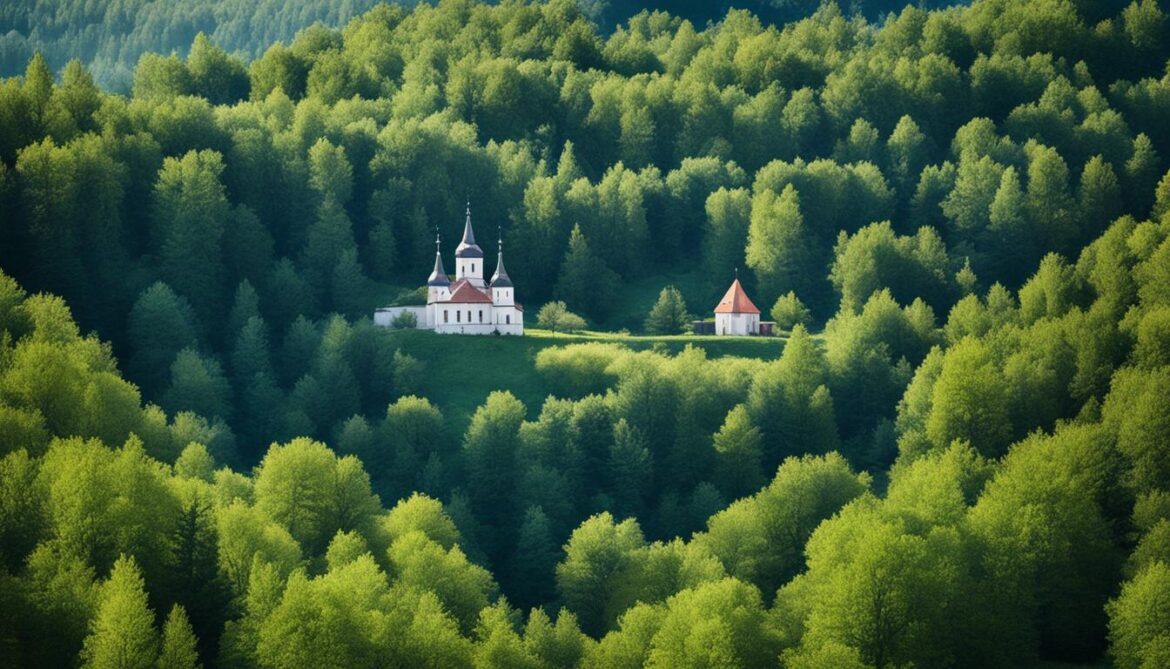
The monastic landscape is a testament to Romania’s commitment to the holistic approach in conservation, recognizing that the preservation of cultural and spiritual values is just as essential as the protection of natural resources. This holistic approach creates a harmonious relationship between the spiritual and the natural, inspiring a deeper connection with the environment and a greater appreciation for the interdependence of all living beings.
“The monastic landscape is a profound expression of the spiritual values that are woven into the fabric of Romania’s cultural heritage. Through the protection of sacred sites, we not only preserve our history and traditions but also honor the spiritual significance of the land.” – Father Ioan, Romanian Orthodox Monastery
By embracing the cultural and spiritual significance of the monastic landscape, Romania recognizes the importance of preserving both tangible and intangible heritage. The monastic communities play a vital role in ensuring the continuity of traditions, serving as living examples of the profound connection between humans, nature, and spirituality. The integration of these values into conservation practices creates a more comprehensive and holistic approach to safeguarding Romania’s natural and cultural heritage for future generations.
The Cultural and Spiritual Significance of Romania’s Monastic Landscape – Key Points:
- Romania’s monastic landscape is managed by Christian Orthodox monastic communities.
- The monastic traditions emphasize the sacredness of nature and living in harmony with the environment.
- Sacred sites within the monastic landscape are protected and integrated into management activities.
- Romania’s holistic approach to conservation recognizes the importance of preserving spiritual values and cultural heritage.
- The monastic communities serve as custodians of sacred sites and promote their significance.
- The monastic landscape inspires a deeper connection between spirituality, culture, and the environment.
- Romania’s commitment to the holistic approach ensures the preservation of both natural and cultural resources.
Examples of Sacred Sites within Romania’s Monastic Landscape
| Sacred Site |
Location |
Monastic Community |
| Moldovița Monastery |
Bukovina |
Moldovița Monastery |
| Cozia Monastery |
Wallachia |
Cozia Monastery |
| Putna Monastery |
Bukovina |
Putna Monastery |
| Sfântul Sava Monastery |
Oltenia |
Sfântul Sava Monastery |
Conclusion
Romania’s sacred natural sites and biodiversity conservation efforts demonstrate the country’s commitment to preserving its spiritual heritage and diverse natural landscapes. By integrating cultural and spiritual values into conservation practices, Romania has achieved a harmonious balance between nature, local communities, and monastic traditions. The country’s natural parks and protected areas serve as living examples of the important role that culture, spirituality, and sustainable development play in biodiversity preservation.
As Romania continues to prioritize the conservation of its natural and cultural heritage, it promises to be an inspiring destination for nature enthusiasts and advocates of spiritual and environmental harmony. Visitors to Romania can witness firsthand the successful coexistence of sacred sites, wildlife, and traditional practices. With its majestic landscapes, thriving wildlife, and rich cultural tapestry, Romania offers an extraordinary experience that celebrates both the natural and spiritual wonders of the country.
By fostering a deeper connection between people and the environment, Romania’s conservation efforts have created a model for sustainable development that can be emulated by other nations. This holistic approach ensures the preservation of biodiversity while nurturing the traditions and beliefs of local communities. Romania stands as a testament to the power of cultural and spiritual values in safeguarding our natural world for future generations.
FAQ
What is the significance of Romania’s sacred natural sites?
Romania’s sacred natural sites hold cultural and spiritual importance and play a vital role in preserving the country’s unique natural heritage.
What is the Carpathian region known for?
The Carpathian region in Romania is known for its rich cultural and ethnic diversity, with minority groups from neighboring countries coexisting with the Romanian majority.
Are there any ancient sacred sites in the Carpathian Mountains?
Yes, the Carpathian Mountains are home to ancient sacred sites associated with the Geto-Dacian civilization, such as the Bucegi Mountain and Ceahla˘u Mountain.
What are Romania’s natural parks and protected areas focused on?
Romania’s natural parks and protected areas focus on preserving specific natural features, geological formations, and representative ecosystems, showcasing the country’s unique landscapes, flora, and fauna.
How do Romania’s sacred natural sites contribute to wildlife conservation?
The presence of monastic communities in these areas promotes a balanced and harmonious relationship between humans and nature, resulting in effective wildlife conservation and sustainable development.
What kind of biodiversity does Romania have?
Romania is home to a wide range of biodiversity, including endemic, rare, and endangered species, with diverse ecosystems supporting unique flora and fauna.
Who is involved in the governance and management of Romania’s natural parks?
The governance and management of Romania’s natural parks involve collaboration between various stakeholders, including the National Forest Administration and local authorities.
How can cultural and spiritual values be integrated into nature conservation efforts?
Recognizing the cultural and spiritual significance of natural sites can enhance awareness, education, and ecotourism strategies, as demonstrated by Romania’s experiences in its natural park management.
What role do Romania’s monastic traditions play in nature conservation?
Romania’s Christian monastic traditions promote sustainable land use practices, supporting the conservation of local biodiversity and agro-biodiversity through harmonious interactions with the natural environment.
What is the cultural and spiritual significance of Romania’s monastic landscape?
Romania’s monastic landscape holds great cultural and spiritual significance, shaped and managed by Christian Orthodox monastic communities for centuries, emphasizing the sacredness of nature and the importance of living in harmony with the environment.

























Post comments (0)